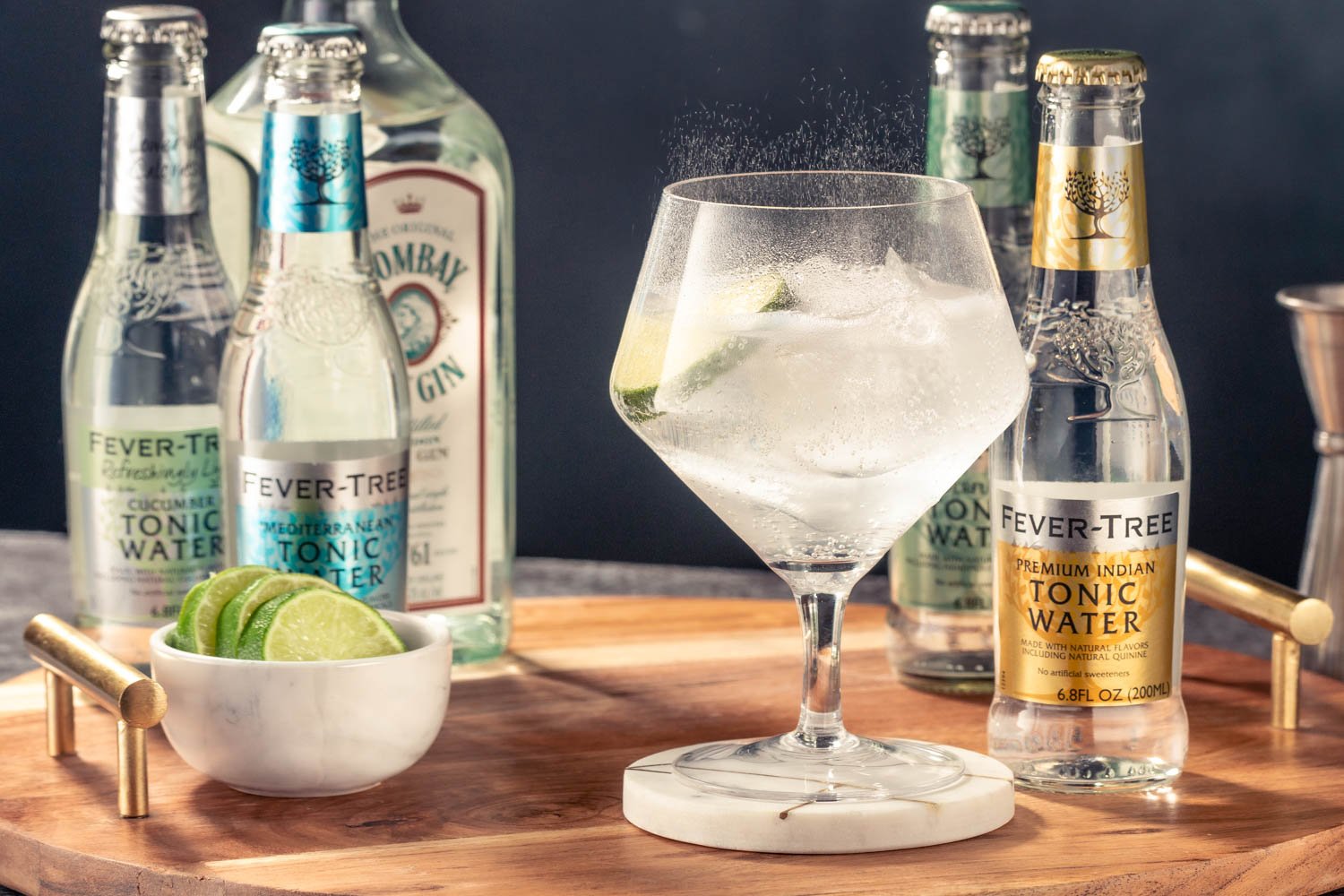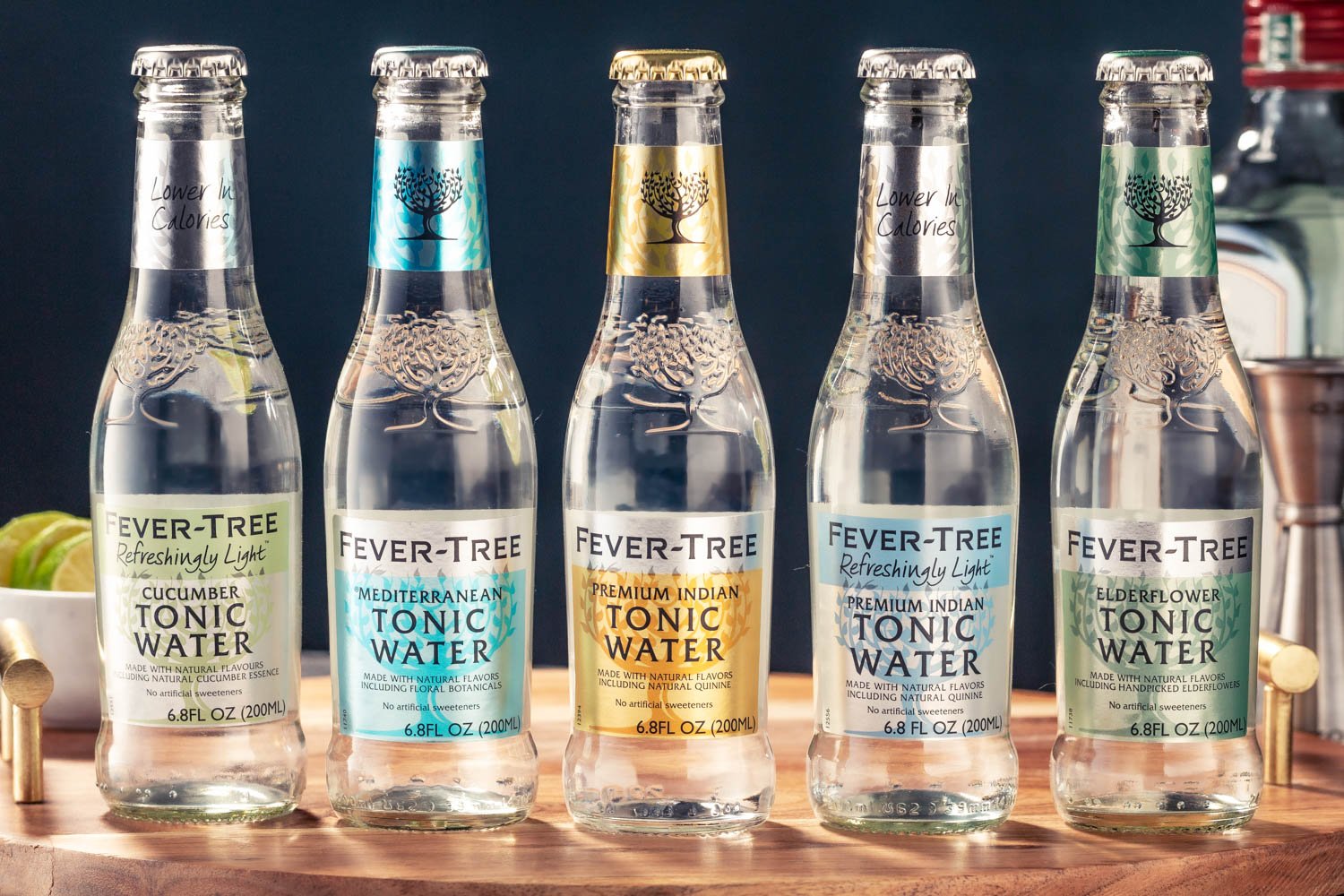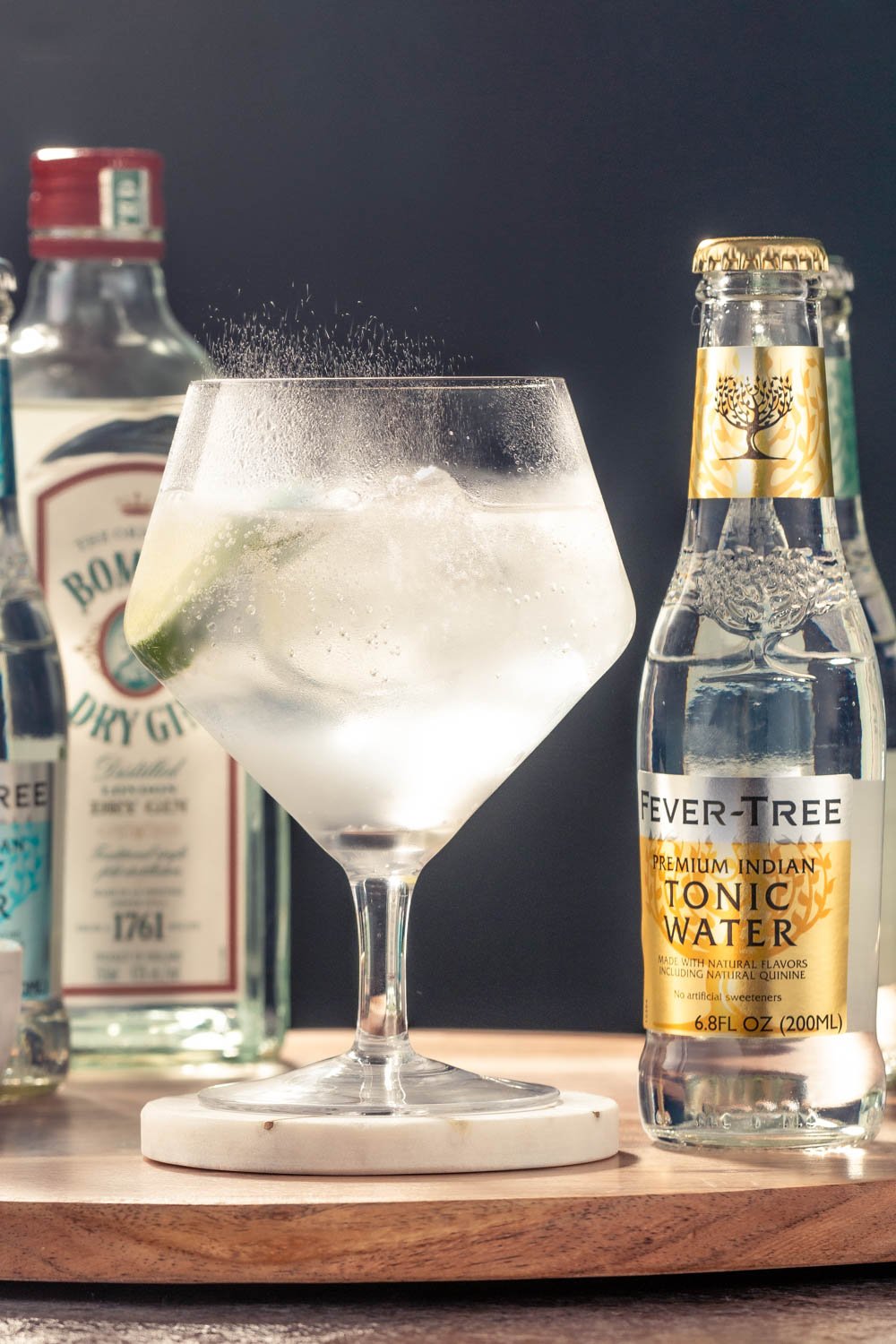
Tips for choosing the proper ingredients and glassware to make an out-of-this-world Gin & Tonic.

Refreshing and simple to make, the gin and tonic is an iconic cocktail that is universally loved. While it may appear basic on the surface with its two ingredients (three if you count the garnish), there are a number of ways to elevate your G&T to a drink full of complex and unique flavors, depending on the quality of the spirit and mixer, the size and shape of the ice, or even which type of glass you use. The margin between that delicious drink and a cup of fizzy water with some gin hiding in it can be very slim without the proper gin & tonic ingredients.
Let’s look at how to make a gin and tonic and provide you with some tips so that your drink tastes as good as possible.
A brief history of the Gin & Tonic
The gin & tonic can trace its roots back to India in the 19th century, where British soldiers were given a dose of quinine to prevent them from contracting malaria in the hot Indian climate. To make the bitter-tasting quinine easier to consume, they mixed it with soda water and sugar (basically tonic water). Officers in the British armies of the East India Company discovered that if they mixed their quinine tonic with their ration of gin and some lime, it created something quite refreshing, and behold, a legendary cocktail was born.
Parts of a Gin & Tonic
Tonic Water

A solid gin & tonic starts with the proper tonic water, and not all tonic waters are created equal. If we had to power rank the different types of tonic water from worst to best, it would go something like this:
- Whatever comes out of the beverage gun behind the bar
- 2-liter of store brand tonic water
- Mass market, corporate brand tonic in a plastic bottle or can
- Premium tonic water made with all-natural ingredients
The goal you want to achieve when choosing your tonic is to have a mixer that doesn’t mask the qualities of your spirit with too much sweetness from artificial sweeteners or doesn’t have enough carbonation which creates a less effervescent drink. Less sugar is the hallmark of a premium tonic water, like the tonic waters from Fever-Tree, which allows the botanicals in your gin to shine.
The original goal of Fever-Tree’s founders was the desire to create the perfect gin & tonic. Their mantra or premise for coming up with a world-class tonic made from all-natural ingredients was that if three-quarters of your drink is the tonic, wouldn’t you want it to be the best? They believed that if people were going to use or pay for a premium spirit, it shouldn’t be diminished by a mixer that wasn’t of the same quality. That has led Fever-Tree to create a range of tonic waters that complement all the different varieties of gin as well as other clear spirits.
Fever-Tree Tonic Water Varieties
Premium Indian Tonic Water: Their flagship tonic water is the classic version that we’ve all come to know and love. Fever-Tree uses quinine made from Cinchona trees in the Democratic Republic of Congo to create the trademark bitterness in their tonic. They also have a Refreshingly Light version of this tonic with less sugar and fewer calories.
Mediterranean Tonic Water: For their Mediterranean tonic, Fever-Tree toned down the quinine and added rosemary and lemon thyme from that part of the world to create a more herbaceous and refreshing tonic that enhances the botanicals in a quality gin.
Elderflower Tonic Water: A light and floral tonic that has the sweetness of freshly picked elderflower.
Refreshingly Light Cucumber Tonic Water: Featuring 43% fewer calories than the rest of Fever-Tree’s tonics, Refreshingly Light Cucumber pairs well with citrus gins to create a refreshing gin & tonic that goes down exceptionally well on a warm summer day.
Tonic Syrup
For those looking to take a more DIY approach to their tonic, tonic syrup is concentrated quinine that you combine with soda water to create your mixer. Typically the recipe for crafting a gin and tonic with tonic syrup is 1 oz of syrup, 2 oz of gin, and 3 oz of soda, but you can adjust the proportions based on your personal preference.
Picking up a bottle of tonic syrup can be a more affordable option than tonic water in the long run because one bottle will allow you to make many more drinks than a single bottle or 4-pack of tonic water. It also has a longer shelf life than tonic water because it’s not carbonated.
Gin
The great part about a gin and tonic is that any type of gin works, whether you prefer a classic, juniper-forward gin or a gin that’s more citrusy or floral. Just like the tonic water, the better quality of your gin, the better your drink is going to taste. While you may not want to spend the big bucks on a top-shelf bottle of gin just to pour it into a glass of tonic water, you also don’t want to add any bargain-priced spirit to it either. For the less experienced gin & tonic connoisseur, we recommend starting out with a good London Dry Gin, such as Beefeater, Tanqueray, or Bombay Sapphire.
Non-Alcoholic Gin
You can also choose to go booze-free with your gin & tonic by using a non-alcoholic gin. There is a growing selection of gin alternatives that recreate the flavor and aromas of a quality gin without the booze. Lyre’s Dry London and Ritual Gin Alternative are two of our favorites in this category. Mix them with tonic the same way you would like your favorite gin for a NA G&T.
Gin to tonic ratio
One common question people have is how much gin and tonic water to use when making their drink. We’ve done extensive research on the subject and get the best results with 1 part gin to 3 parts tonic for a 3:1 tonic to gin ratio.
Fever-Tree tonic waters are available in 6.8 oz single-serve bottles which make them perfect for topping a 2 oz pour of your favorite gin to create a tasty drink. You can use a 2:1 ratio for a stronger gin & tonic, but it ultimately depends on your personal preference. No matter which ratio you choose, please drink responsibly.
Gin & Tonic garnishes
No gin and tonic is complete without a proper garnish. The classic choice is a wedge or slice of lime that is squeezed into your drink first (or squeeze one into your drink and place a fresh one in your glass). Other types of citrus that are popular choices include lemon, orange, and grapefruit. Dehydrated slices of citrus make for an excellent garnish option when you need to cut down on either prep time or the potential for wasted fruit.
The expanding selection of more flavorful gins and the popularity of wider glassware for gin and tonics have allowed for a more diverse variety of options when adding a garnish to your drink. Now you can find juniper berries, rosemary, star anise, and even lavender floating in one’s G&T to add more flavor and botanicals to your drink. The only restriction on what garnishes to use is your tastes and your imagination!
Choosing the right ice for a gin & tonic
The first thing that goes into a good gin & tonic is plenty of ice, but not just any ice will do. The key is to use large ice cubes to chill your drink because larger ice cubes melt slower and won't dilute your drink as quickly. Small ice cubes or crushed ice can melt much faster so it won’t take long before you have a watered-down G&T sitting in your glass. The more ice you can fill your glass with is also a good way to prevent your drink from becoming diluted quickly.
Gin & Tonic glassware

When you reach for a glass to make your gin & tonic there are a few different options you have at your disposal. Most G&T drinkers are familiar with the taller highball glasses that allow you to stack plenty of ice in your drink and still have room for a slice of lime. A taller glass will keep your drink fizzier for longer as well. You can also use a rocks glass with some larger ice cubes for a refreshing drink that is easy to hold.
The use of wine glasses or goblet-style (balloon) glasses for gin & tonics has recently become popular. The larger opening allows you to experience more of the aromatics in your gin while providing room for more unique and larger garnishes (see above). The finished product can be very visually appealing.
When using this type of glass, be sure to not overfill it with tonic which will cover up your gin. Your tonic can also go flatter faster when using a balloon glass if you tend to enjoy your G&T slowly because more of the liquid is exposed to the air.
Gin & Tonic Cocktail Recipe
Yield: 1 cocktail
Ingredients
- 2 oz Dry London Gin
- 1 6.8 oz bottle Fever-Tree Tonic Water
- Lime (for garnish)
Glassware
Tools
Instructions
Fill a glass with ice. Pour gin into glass and top with tonic water. Squeeze lime wedge into glass and then add lime garnish.

Tags:

Dave Buchanan
Dave Buchanan has been the Content Writer for Kegworks since June 2019. He has a fondness for craft beer that developed while working for a local beer distributor. Dave also worked for an area sports talk radio station for several years, and continues his broadcasting work as a motorsports announcer and indoor lacrosse reporter.



Leave a Comment